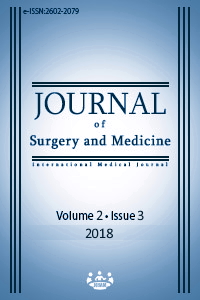An evaluation of the infection agents and the demographic characteristics of patients followed up on a mechanical ventilator in neurology intensive care: A retrospective, single center, observational study
Keywords:
Nosocomial infection, Neurological intensive care unit, Mechanical ventilatorAbstract
Aim: The incidence of nosocomial infections is higher than other sites of the hospitals at intensive care units (ICU) because of high frequency of invasive interventions and multidrug resistant microorganism’s prevalence. Ventilator-related pneumonia cases have the highest mortality risk among the nosocomial infections. The aim of this study was to evaluate the endotracheal aspirate cultures and the demographic characteristics of patients followed up on mechanical ventilation in Neurology Intensive Care.
Methods: Our study was designed as a retrospective, cross-sectional and descriptive. Retrospective evaluation was made of 51 patients who were attached to a mechanical ventilator in the last 6 months and from whom a tracheal aspirate culture was taken. The endotracheal aspirate samples were taken under sterile conditions using a specifically designed catheter with the method of administering saline into the intubation tube and then aspiration. Blood culture results sent for analysis at the same time as the tracheal aspirate samples were also retrospectively evaluated in patients determined with positive production. A record was made of the demographic characteristics of the patients, diagnosis on admittance to ICU, risk factors, and microbial production in the tracheal aspirate culture.
Results: In the first culture, there was no production in 22 (43.1%) cases, and Acinetobacter baumanii was determined in 14 (27.5%) patients, Pseudomonas aeruginosa in 3 (5.9%), Klebsiella pneumonia in 3 (5.9%), Staphylococcus aureus in 2 (3.9%), Corynebacterium striatum in 2 (3.9%), Acinetobacter baumanii + Pseudomonas aeruginosa in 2 (3.9%), Acinetobacter baumanii + Klebsiella pneumonia in 2 (3.9%), and Acinetobacter baumanii + Escherichia coli in 1 (2.0%). The second culture was taken from patients on the mean 11th day. In 3 (10.7%) patients there was no production in the second culture and in the other patients, Acinetobacter baumanii was determined in 15 (53.6%) patients, Pseudomonas aeruginosa in 3 (10.7%), Klebsiella pneumonia in 2 (7.1%), Escherichia coli in 1 (3.6%), Corynebacterium striatum in 1 (3.6%), and Acinetobacter baumanii + Pseudomonas aeruginosa in 3 (10.7%).
Conclusion: The culture results in this study of patients admitted for neurological reasons were observed to be consistent with findings in literature. The high mortality rate of 64.7% in these ICU patients is due to the majority being ischemic stroke patients. This suggests that both the severe table associated with neurological findings and agents such as Acinetobacter baumanii and Pseudomonas aeruginosa contribute to Neurology ICU patients.
Downloads
References
Walaszek M, Rozanska A, Bulanda M, Wojkowska-Mach, J. Epidemiology of healthcare-associated infections in Polish intensive care. A multicenter study based on active surveillance. Biomed Pap Med Fac Univ Palacky Olomouc Czech Repub. 2018;72(1):33-44.
Küme G, Demirci M. Antimicrobial susceptibilities of nonfermentative gram negative bacteria isolated from lower respiratory tract samples of patients in intensive care units and risk factors associated with lower respiratory tract infection. DEÜ Faculty of Medicine Journal. 2012;26(1):37–4.
Hinduja A, Dibu J, Achi E, Patel A, Samant R, Yaghi S. Nosocomial infections in patients with spontaneous intracerebral hemorrhage. American Journal of Critical Care. 2015;24(3):227-31.
Inanc Y, Gokce M, Tuncel D, Inanc Y,Ozcekic Demirhan S, Bavli S. Percutaneous endoscopic gastrostomy in neurology intensive care unit. IJSM. 2018;4(1):33-5.
Safdar N, Dezfulian C, Collard HR, Saint S. Clinical and economic consequences of ventilatorassociated pneumonia: a systematic review. Critical care med. 2005;33:2184.
Nseir S, Martin-Loeches I. Ventilator-associated tracheobronchitis: Where are we now? Rev Bras Ter Intensiva. 2014;26:212–4.
Bassetti M, Taramaso L, Giacobbe DR, Pelosi P. Management of ventilator-associated pneumonia: epidemiology, diagnosis and antimicrobial therapy. Expert Rev Anti Infect Ther, 2012;10:1405-23.
Houck PM, Bratzler DW, Nsa W, Ma A, Bartlett JG. Timing of antibiotic administration and outcomes for Medicare patients hospitalized with community-acquired pneumonia. Arch Intern Med. 2004;164(6): 637-44.
Ray U, Ramasubban S, Chakravarty C, Goswami L, Dutta S. A prospective study of ventilator-associated tracheobronchitis: incidence and etiology in intensive care unit of a tertiary care hospital. Lung India: official organ of Indian Chest Society. 2017;34(3):236.
Namıduru M, Güngör G, Karaoğlan I, Dikensoy O. Antibiotic resistance of bacterial ventilator associated pneumonia in surgical intensive care units. J Int Med Res. 2004;32:78-83.
Mi H, Li S, Li H, Hu W. The effects of infection on severe stroke patients in the neurological intensive care unit in China. Int J Neurosci. 2018 Aug;128(8):715-20.
Downloads
- 1329 1802
Published
Issue
Section
How to Cite
License
Copyright (c) 2018 Yılmaz İnanç, Yusuf İnanç
This work is licensed under a Creative Commons Attribution-NonCommercial-NoDerivatives 4.0 International License.















